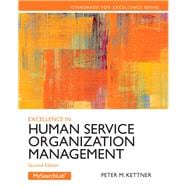An integrated model for management and administrative practice.
Excellence in Human Service Organization Management, 2/e provides guidelines to insure internal consistency within Human Service Organizations. Integrated in management theory, the model presented in the text is adapted to human service organizations generally and social work issues specifically. The text first identifies problems in organizational functioning as well as proposes what managers need to do to put their organizations back on track toward excellence. Then it guides managers through a plan to bring employees on board and continuously nurture them so they identify their success with that of the organization. Standards for Excellence Series -- Designed to help students advance their knowledge, values, and skills, the Standards for Excellence Series assists students in associated CSHSE's National Standards to all levels of human service practice.
Learning Goals
Upon completing this book, readers will be able to:
- Identify problems in organizational functioning.
- Recognize what managers need to do to get organizations on the track for excellence.
- Understand what employees need to do to help the overall well-being of an organization.











